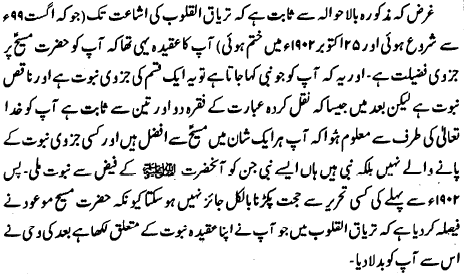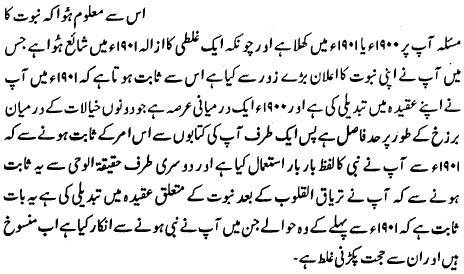Showing Islam is Peaceful • Tolerant • Rational • Inspiring
| Home
|
| 1.
Islam |
| 2.
Ahmadiyya Movement Refuting the Qadiani Beliefs ‘Change of claim in 1901’ theory collapses under its own contradictions |
| 3.
Publications & Resources |
‘Change of claim in 1901’ theory collapses under its own contradictionsCompiled by Dr Zahid AzizWhen the Qadiani Khalifa Mirza Bashir-ud-Din Mahmud Ahmad started trying to prove that Hazrat Mirza Ghulam Ahmad had claimed to be a prophet, he and his followers were faced with the great difficulty that Hazrat Mirza had denied claiming to be a prophet in his writings. To overcome this difficulty, they invented the theory that Hazrat Mirza had realized after a certain date that he was indeed a prophet, and therefore all his denials of prophethood before that date must be regarded as having been cancelled and no longer applicable. Here we show the various bizarre turns and twists taken by the Qadiani Jama‘at upholders of this theory, which have led to its complete collapse. Date of change set at October 1902In his book Al-Qaul-ul-Fasl, published on 30th January 1915, Mirza Mahmud Ahmad set this date at October 1902, alleging that Hazrat Mirza has changed his claim to prophet subsequent to the publication of his book Tiryaq-ul-Qulub in October 1902. So Mirza Mahmud Ahmad writes:
The translation of the above extract is as follows:
(Note: Mirza Mahmud Ahmad misinterpreted an answer to a question given by Hazrat Mirza Ghulam Ahmad in his book Haqiqat-ul-Wahy, published in May 1907, and took it to mean that he had changed his earlier standpoint expressed in the book Tiryaq-ul- Qulub, published in October 1902 — that he is a “non-prophet” and only excels Jesus in some limited respects as a non-prophet — and subsequently realised that he was, in fact, a prophet. We discuss this point elsewhere.) However, in this same book Al-Qaul-ul-Fasl, Mirza Mahmud Ahmad had given quotations from Ayk Ghalati Ka Izala to show that in this booklet Hazrat Mirza Ghulam Ahmad had claimed to be a prophet (see, for example, the very next page of Al-Qaul-ul-Fasl in Anwar-ul-‘ulum, v. 2, book no. 8, p. 286). Now this pamphlet was published on 5 November 1901, almost one year before 25 October 1902. Thereupon, Maulana Muhammad Ali raised the objection that Mirza Mahmud Ahmad, by quoting from Ayk Ghalati Ka Izala, was violating his own rule that “it is absolutely unallowable to use any writing before 1902 as evidence”. Date changed to November 1901Two months later, when Mirza Mahmud Ahmad published another book on this subject in March 1915, entitled Haqiqat-un-Nubuwwat, he wrote in it:
First Mirza Mahmud Ahmad set the date of change of claim as being after October 1902 because Hazrat Mirza was denying being a prophet in the book Tiryaq-ul-Qulub published in October 1902. Then when it was pointed out that he was using Ayk Ghalati ka Izala, published in November 1901, to prove that Hazrat Mirza claimed to be a prophet, he altered the date of change of claim to “1900 or 1901”. The very fact that Mirza Mahmud Ahmad changed this date is conclusive proof that it was his own invention and that Hazrat Mirza never mentioned any date after which his claim changed from non-prophet to prophet. Moving back date of writing of Tiryaq-ul-QulubThe question then arises, if “the issue of prophethood became clear to him in 1900 or 1901”, how is it that in Tiryaq-ul-Qulub, which is dated by Hazrat Mirza Ghulam Ahmad as 25 October 1902 at the end of the book, and whose title page bears the date 28 October 1902, he has stated his claim and rank to be that of a non-prophet? In explanation of this, Mirza Mahmud Ahmad and his Jama‘at have taken great pains to try to prove that the book Tiryaq-ul-Qulub was in fact written in 1899, and thus pre-dates Ayk Ghalati Ka Izala. (See Haqiqat-un-Nubuwwat in Anwar-ul-‘ulum, v. 2, book no. 10, p. 365 onwards, and also the introduction in Ruhani Khaza’in volume 15, by Maulana Jalal-ud-Din Shams, the volume containing Tiryaq-ul-Qulub.) However, it is simply untenable and incredible that, if Hazrat Mirza Ghulam Ahmad had announced the changing of his claim in November 1901 to that of being a prophet, he would have published a book in October 1902 which, being written in 1899, expressed his former claim, and yet he did not add a note to it, to caution the reader that the book contained his old claim which had been superceded by a new claim. According to the Qadiani Jama‘at explanation, the book Tiryaq-ul-Qulub up to page 158 had been written in 1899, and Hazrat Mirza merely finished it off in October 1902 by writing the last two pages, 159 and 160, and published it. However, it so happens that his statement which they declare as cancelled, that is to say, the statement that he is a non-prophet (ghair nabi), occurs at the very end of page 157. This makes it all the more necessary, and expected, that on pages 159 to 160 he should have told the readers that his statement on page 157 was now outdated. We find that he begins a new topic on page 154 which continues unbroken till the end of the book. (In the Ruhani Khaza’in collection, this page range of Tiryaq-ul-Qulub corresponds to volume 15, pages 475–486.) This makes it absolutely certain that his statement on page 157, that he is a non-prophet, was still his claim when he finished writing this book on 25th October 1902. Confirmation of pre-1901 belief in Haqiqat-ul-Wahy in 1907In his book Haqiqat-ul-Wahy, published in May 1907, Hazrat Mirza Ghulam Ahmad recounts an incident in a courtroom that occurred in 1904:
His rank and status as stated in the book Tiryaq-ul-Qulub is that he is a non-prophet and a muhaddas (i.e., a Muslim saint who receives revelation in the manner that non-prophets can receive revelation). Changing name of book fails to workTo undo this powerful argument, the Qadiani Jama‘at publishers of Ruhani Khaza’in have added a footnote in Haqiqat-ul-Wahy at this point to say that his mention of the book Tiryaq-ul-Qulub is an error of memory by him and that he was actually asked about the book Tuhfa Golarwiyya, published in September 1902. However, it turns out that the Qadiani Jama‘at publishers, discussing in the same collection Ruhani Khaza’in as to when the book Tuhfa Golarwiyya was written, say:
Thus the book Tuhfa Golarwiyya, according to Qadiani Jama‘at scholars, belongs to the same period of writing as Tiryaq-ul-Qulub, the period about which they admit that during it Hazrat Mirza Ghulam Ahmad claimed to be a non-prophet and denied claiming to be a prophet. Therefore, it makes no difference if he was asked in court about Tuhfa Golarwiyya and not Tiryaq-ul-Qulub. In either event, the facts are that:
If he had changed his claim to that of being a prophet in 1901, he could not have done either of these two things. Thus the attempts by the Qadiani Jama‘at to prove its theory of ‘change of claim in 1901’ only caused this theory to collapse even more. This is why there are now hardly any members of the Qadiani Jama‘at who know of even the existence of this theory. |

